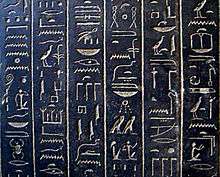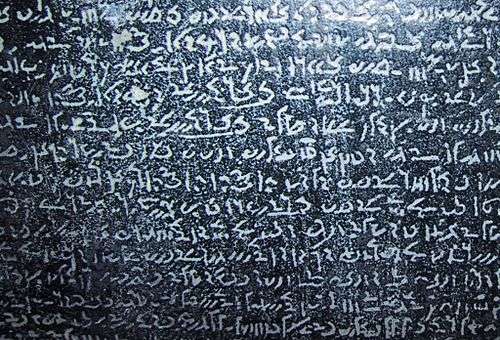Writing in ancient Egypt
There were several types of writing in ancient Egypt. From the earliest Protodynastic Period of Egypt, Egyptian language was recorded both in the Egyptian hieroglyphics, and in the Hieratic form. Additionally, there was a variety of stone-cut hieratic known as lapidary hieratic.
Later on, especially during the Ramesside Period, cursive hieroglyphs also became popular. This form of writing was used for religious documents on papyrus, such as the multi-authored Books of the Dead. This script was closer to the stone-carved hieroglyphs, but was not as cursive as hieratic, lacking the wide use of ligatures.
| ||||||
| sẖ3 n mdww nt̪r in hieroglyphs |
|---|
The native name for Egyptian hieroglyphic writing is sẖ3 n mdww nt̪r or "writing of the words of god."
Most remaining texts in the Egyptian language are primarily written in the hieroglyphic script. However, in antiquity, the majority of texts were written on perishable papyrus in hieratic and (later) demotic, which are now lost.
From around 650 BCE onward, the Demotic (Egyptian) script developed from Hieratic.
In the language's final stage of development, the Coptic alphabet replaced the older writing systems.
As Egypt became part of the Greek and (later) the Roman empire, the hieroglyphic writing system was replaced by the Greek alphabet used first to write magical and later Christian manuscripts. A few extra characters had to be added to represent sounds of the Egyptian language which did not exist in the Greek pronunciation of the time (e.g., the phoneme /f/). These characters were taken from the demotic script.
Hieroglyphic usage

Hieroglyphic writing dates to c. 3200 BC, and is composed of some 500 symbols. A hieroglyph can represent a word, a sound, or a silent determinative; and the same symbol can serve different purposes in different contexts. Hieroglyphs were a formal script, used on stone monuments and in tombs, that could be as detailed as individual works of art. In day-to-day writing, scribes used a cursive form of writing, called hieratic, which was quicker and easier. While formal hieroglyphs may be read in rows or columns in either direction (though typically written from right to left), hieratic was always written from right to left, usually in horizontal rows. A new form of writing, Demotic, became the prevalent writing style, and it is this form of writing-along with formal hieroglyphs-that accompany the Greek text on the Rosetta Stone.
Hieroglyphs were used for most of the surviving forms of written communication during the Old and Middle Egyptian eras, at least for official documents; hieratic was already being used for day-to-day administrative needs during the Old Kingdom. Religious texts during the Demotic era were also typically written in hieroglyphs when they were inscribed on temple walls and stelae; hieratic was used for religious documents on papyrus. (Administrative works were of course written in Demotic.) The last datable hieroglyphic text was written in 394 AD. and they were written across (left to right, or vice versa) or vertically (up and down, or vice versa).
Coptic alphabet
Around the 1st century AD, the Coptic alphabet started to be used alongside the Demotic script. Coptic is a modified Greek alphabet with the addition of some Demotic signs. Although formal hieroglyphs were used in a ceremonial role until the 4th century, towards the end only a small handful priests could still read them.
Dual use of hieroglyphs
| pr biliteral | pr (house) | pr(y) (go out) | |||||||
|
|
|
Hieroglyphs are employed in two ways in Egyptian texts: as ideograms that represent the idea depicted by the pictures; and more commonly as phonograms denoting their phonetic value.
For example, the hieroglyph representing the biliteral pr is typically used as an ideogram to denote the word 'house'. In addition, the same glyph is used as a phonogram to write the word pr(y) 'to go out' due to the similarity in pronunciation. To leave no doubt as to which word is actually meant, a vertical stroke is drawn underneath the glyph to mean 'house', whereas a pair of walking legs is added next to the same glyph to clarify that pr(y) 'go out' is meant instead. To further clarify the pronunciation, the hieroglyph for mouth (ro) is typically added in between the house and the walking legs, so that the whole combination encodes the word pr(y) like this: "Word that sounds like a word for house which ends in an r and is related to walking => to go out". Hieroglyphic writing is thus an intricate mixture of phonetic and semantic components.
Calligraphy
The majority of hieroglyphs seen in any particular text do not represent the objects they depict. They mostly represent sounds or were used as "determinatives" to show what conceptual category the word referred to. Hieroglyphic could be written in the following ways:
- horizontal, left-to-right
- horizontal, right-to-left
- vertical, facing left-to-right
- vertical, facing right-to-left
It is generally an easy task to determine which way to read the hieroglyphs even if the meaning is not understood. Hieroglyphs with a definite front and back (for example, a human or animal) will generally face the beginning of the sentence, as well as being oriented in the same direction as any large human or divine figure in the associated art work. (However, in some instances, they will be reoriented out of respect to face any important personage, such as a king or deity.)
As an example, if a tableau contains a picture of a man seated and facing right, then all hieroglyphs written in text above or behind the man, and having a definite front and back, would be oriented to the right as well. The actual hieroglyphs would be read from right-to-left because these images almost always face the beginning of the sentence. (Text written in front of the man might very well be oriented to the left, facing the man out of respect.)
Hieroglyphic texts that do not display this behaviour are said to be in retrograde. Once one understands hieroglyphic it is easy to determine if one is examining a retrograde text because it will simply make no sense if read normally.
As an aid to reading, and perhaps to the ancient Egyptians' sense of aesthetics, hieroglyphs were also packed together into neat patterns. In general, two or more short or thin symbols (depending on which direction one was writing the hieroglyphs) would be written in the same block as each other. Occasionally, a tall or wide symbol would be made smaller and placed with another short or thin hieroglyph. Beginning in the New Kingdom, however, these compositional blocks were lengthened, often becoming virtual columns, albeit short ones if written in an otherwise horizontal text.
Finally, hieroglyphic had no standard punctuation. Religious texts generally have no punctuation at all, while texts from the latter part of the ancient Egyptian language have full stops between important lines of thought.
Decipherment of hieroglyphic writing

As the traditional religious establishments were disbanded, knowledge of hieroglyphic writing was mostly lost. Attempts to decipher them date to the Byzantine and Islamic periods in Egypt, but only in 1822, after the discovery of the Rosetta stone and years of research by Thomas Young and Jean-François Champollion, were hieroglyphs almost fully deciphered.
For a long time, the decipherment of hieroglyphics was hampered because those attempting to decipher them assigned emotional meanings to the actual symbols used. For example, some people believed that the hieroglyph for son, a goose, was chosen because geese love their sons above all other animals. This hieroglyph was chosen, though, simply because the word for goose once had the same sound as the word for son. A further impediment was the lack of complementary material, that is to say material of the same work written close to another translation.
Athanasius Kircher, a student of Coptic, developed the notion that this last stage of Egyptian could be related to the earlier Egyptian stages. Because he was not able to transliterate or translate hieroglyphic he could not prove this notion.
In 1799 when the discovery of the Rosetta Stone occurred, scholars finally had an example of hieroglyphic, demotic and Ancient Greek that they were all reasonably certain were the translations of the same passage. In hieroglyphic, the name of the King or Pharaoh and gods' names are often placed within a circle called a cartouche. Jean-François Champollion, a young French scholar, demonstrated how the name Kleopatra could be made in hieroglyphic. Furthermore, by using an impressive knowledge of Coptic he surmised that a number of symbols showing everyday objects could be pronounced as in Coptic.
Applying this knowledge to other, well-known hieroglyphic sources clearly confirmed Champollion's work and linguistic scholars now had a way to work with and delineate the language into nouns, verbs, prepositions and other grammatical parts.
Non-native scripts
Other texts discovered in Egypt and dating to the period before Islam include those written in:
- the Greek alphabet
- the Latin alphabet
- the Cuneiform script
- the Old Persian cuneiform script
- Tifinagh, particularly in the Bahariya Oasis
- the South Arabian alphabet
- the Aramaic alphabet at Elephantine for the Elephantine papyri
- the Syriac alphabet
- the Carian alphabet, which is well attested at the Precinct of Amun-Re of Karnak temple at Thebes
- the Phoenician alphabet, particularly at Memphis and Abu Simbel
- the Nabataean alphabet in the Sinai region
See also
Notes and references
| ||||||||||||||||||||||
